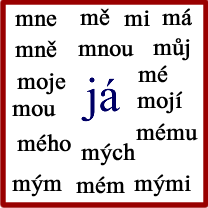
Recently I have been learning some more Czech. I work through a few lessons on Duolingo and Mondly every day. Even though it’s many years since I last studied any Czech, I find I can understand quite a lot, and guess unknown words from context. One thing I struggle with though is all the noun declensions, and the many different forms of pronouns.
Czech has seven noun cases, so nouns and pronouns can come in up to fourteen different forms (6 or 7 in the singular and 6 or 7 in the plural), depending on the role they play in a sentence. In fact the plural forms are the same for some cases, but singular pronouns have long and short forms, and different forms after prepositions.
For example, I is já in the nominative, which is mainly used for emphasis and is generally dropped – (Já) vidím tě = I see you. The nominative singular of you is ty: tě is the accusative (and genitive) short form – the long form is tebe. Word order is flexible, so you could also say Tě vidím or Já tě vidím. Is there any difference in emphasis between the different word orders?
Some more examples:
- Vidíš mě = You see me
- Mluvíš se mnou = You are talking to me
- Dáváš mi peníze = You are giving me money
- Nemluv o mně = Don’t look at me
- Vidíš můj dům = You see my house (dům [house] is masculine)
- Vidíš moje domy = You see my houses
- Vidíš mou kočku = You see my cat (kočka [cat] is feminine)
- Vidíš moje kočky = You see my cats
- Vidíš moje auto = You see my car (auto [car] is neuter)
- Vidíš moje auta = You see my cars
- k mému překvapení = to my surprise
- Odpovězte, prosím, na mou otázku = Please answer my question
- Váš dům je blízko mého = Your house is near mine
This are some forms of the first person singular pronoun (I, me, my, mine). There are as many, it not more, for other pronouns. Maybe one day I’ll be able to recognize and use them all.
I have often thought that prepositions are the most difficult to learn, because they seem to be defined (or greatly influenced) by context, and are vulnerable to (mis)use in slang.
For instance, the English sentence, “What have you been up to?” is perfectly understandable to an English speaker that has heard such things all their life. But, “up”? “to”? The question has nothing to do with location or directionality, and has nothing to do with movement, as if “to” had meant “towards”.
Worse, the sentence can be rewritten as “What have you been doing?” which has exactly the same meaning without use of (or need for) any prepositions at all, suggesting that “up to” was not needed in the first place.
But, the closest rewrite of the sentence that is also grammatical is “How have you been?”, a sentence that does not really convey the same meaning, since it does not ask what a person was doing, but is understood as inquiry into a person’s health and well-being. That means the prepositions “up” and “to” that (seemingly) have no grammatical purpose are actually vital to asking the right question after all.
No wonder prepositions are so hard.
I see that my comment about prepositions was a little off-topic, since we were supposed to be talking about pronouns. My bad. I meant well.